Control Technology of Surface Movement Scope with Directional Hydraulic Fracturing Technology in Longwall Mining: A Case Study
Abstract
:1. Introduction
- (1)
- Management methods, that is, the relocation of surface buildings.
- (2)
- (1)
- The relocation mode has problems such as land acquisition, contradiction between workers and residents, and one-time investment in relocation funds.
- (2)
- Strip mining [11,12] causes serious loss of resources, and its recovery efficiency is generally low, which is unfavorable to the development of the enterprise, moreover, it is difficult to ensure the long term stability of coal pillars, and the coal pillars in the gob are prone to failure and cause serious damage to the surface.
- (3)
- For filling mining, the demand for filling materials is large, and the initial input and production costs are relatively high; the effect of reducing subsidence of grouting bed separation is poor [13], because the location of the separation layer is difficult to determine.
- (4)
- The effect of coordinated mining [14] dealing with reducing subsidence is not good, and the resulting surface deformation position will cause seasonal water accumulation.
2. Mechanism of Mining-Induced Surface Movement Scope Control by Weak Planes
3. Numerical Simulation Analysis
3.1. Description of Mining and Geological Conditions
3.2. Model Construction and Simulation Plans
3.2.1. Introduction of 3DEC Software
3.2.2. Establishment of Model and Selection of Parameters
- The division of joints in the surface soil layer is smaller than that in general bedrock, and the size of its fragmentation is relatively small.
- The fragmentation of the joints of the key layers in the bedrock is longer than that of other strata, and the division is mainly based on the fracture distance.
- The horizontal displacement was fixed at the lateral boundary.
- The vertical displacement was fixed at the bottom boundary.
- The model is directly simulated to the surface, so the top is a free boundary, and the model is only affected by its own gravity.
3.3. Numerical Simulation Results and Analysis
- (1)
- After the coal seam excavation was completed and the model was stable, the advance angle of influence changed from 53.61° to 59.15° with weak planes heights ranging from 0 m to 120 m, and the advance distance of influence changing from 173.31 m to 140.27 m which decreased by 30.04 m.
- (2)
- Compared with the condition without weak planes, when the weak planes dips were 30° and 60°, the advance distance of influence increased to more than 250 m and 209.83 m, respectively. Meanwhile, the advance angle of influence decreased to less than 45°and 48.26°, respectively. However, when the weak planes dip was 90°, the advance distance of influence decreased to 167.13 m, and the advance angle of influence increased to 54.57°.
4. Case Studies
4.1. Study Area Overview
4.2. Design of Overburden Hydraulic Fracturing
- (1)
- Before mining, drill holes were arranged according to the set drilling parameters on the roof of the tailgate. When the bit drilled to the slotting position, the slotting bit replaced and grooved at the bottom of the borehole. After grooving, the slotting bit withdrew, and the ordinary bit replaced it to continue drilling. Then the grooving process was carried out at the next slotting position, so that the drilling cycle would be completed at the end of the drilling, as shown in Figure 15c.
- (2)
- Then, the inflatable straddle packer used to seal the fracturing section before and after grooving, and the backward fracturing method used for sealing and water injection fracturing, that is, from the groove at the bottom of the borehole to the outward sequential fracturing. The high-pressure water pump was connected with water first and then electrified, and then slowly pressurized. At the same time, the pressure gauge data of the pump and manual pump recorded. The pressure would continue to pressurize until the pre-crack cracks occurred. At this time, the pressure would suddenly drop, and the pressure-retaining water injection would make the cracks continue to expand. When water seeped out from the roof, coal wall or borehole of the roadway, the fracturing stopped immediately, and the main hydraulic crack and branch airfoil crack was created in the overburden rock at the fracturing site, as shown in Figure 15b.
- (3)
- The above operations were repeated in turn until a hydraulic fracturing broken zone intersecting airfoil branching cracks formed between boreholes as shown in Figure 15a. When the face mined near the hydraulic fracturing section, the overburden at face end slid along the broken zone under the action of overburden stratum pressure and self-gravity.
4.3. Application Effects and Field Measurements
5. Conclusions
- (1)
- After the coal seam mined out, the overburden bedrock was divided into three different mining influence zones in the horizontal direction according to vertical displacement of overburden: the undisturbed zone, the triangular slip zone and the stacking zone of broken rock block. Among them, the characteristics of the triangular slip zone was the key to controlling the surface movement scope.
- (2)
- Numerical simulation models were established to study the influence of weak planes on overlying strata movement. When the weak planes dip was bigger than the angle of critical deformation, the advance angle of influence changed from 53.61° to 59.15° with weak plane heights ranging from 0 m to 120 m, and the advance distance of influence changed from 173.31 m to 140.27 m which decreased by 30.04 m. With the increase of the weak planes’ height, the mining influence scope showed a decreasing trend.
- (3)
- The field test results of panel 5304 in Sihe coal mine showed that buildings (structures) formerly in mining-affected areas did not appear to have cracks or mining damages after mining by using hydraulic fracturing technology in overburden, which proved the feasibility of this technology. This work is of important theoretical value and practical significance to surface subsidence control and sustainable coal mining with similar geological mining conditions, and provides a new method for mining damage and protection under buildings (constructions), railways, and water bodies.
Author Contributions
Funding
Acknowledgments
Conflicts of Interest
References
- Peng, S.S. Topical areas of research needs in ground control—A state of the art review on coal mine ground control. Int. J. Min. Sci. Technol. 2015, 25, 1–6. [Google Scholar] [CrossRef]
- Bell, F.G.; Donnelly, L.J. Mining and Its Impact on the Environment; CRC Press: Boca Raton, FL, USA, 2006. [Google Scholar]
- Yilmaz, I.; Marschalko, M. A leaning historical monument formed by underground mining effect: An example from Czech Republic. Eng. Geol. 2012, 133–134, 43–48. [Google Scholar] [CrossRef]
- Sampurna, A.; Joseph, S.; Thomas, N. Development of a flooded-bed scrubber for removing coal dust at a longwall mining section. Saf. Sci. 2018, 110, 204–213. [Google Scholar]
- Guo, W.B. Coal Mining Damages and Protection; Coal Industry Press: Beijing, China, 2013; pp. 39–41. [Google Scholar]
- Chen, S.J.; Wang, H.L.; Wang, H.Y.; Guo, W.J.; Li, X.S. Strip Coal pillar design based on estimated surface subsidence in eastern China. Rock Mech. Rock Eng. 2016, 49, 3829–3838. [Google Scholar]
- Cao, W.H.; Wang, X.F.; Li, P.; Zhang, D.S.; Sun, C.D.; Qin, D.D. Wide strip backfill mining for surface subsidence control and its application in critical mining conditions of a coal mine. Sustainability 2018, 10, 700. [Google Scholar] [CrossRef]
- Zhang, Q.; Zhang, J.X.; Wu, Z.Y.; Chen, Y. Overview of solid backfilling technology based on coal-waste underground separation in China. Sustainability 2019, 11, 2118. [Google Scholar] [CrossRef]
- Sun, W.; Wang, H.J.; Hou, K.P. Control of waste rock-tailings paste backfill for active mining subsidence areas. J. Clean. Prod. 2018, 171, 567–579. [Google Scholar] [CrossRef]
- Li, M.; Zhang, J.X.; An, B.F.; Deon, M.G.; Xu, Q.Q. Effect of cyclic lateral loading on the compaction behavior of waste rock backfill materials in coal mines. Energies 2019, 12, 17. [Google Scholar] [CrossRef]
- Yu, Y.; Deng, K.Z.; Luo, Y.; Chen, S.E.; Zhuang, H.F. An improved method for long-term stability evaluation of strip mining and pillar design. Int. J. Rock Mech. Min. Sci. 2018, 107, 25–30. [Google Scholar] [CrossRef]
- Tan, Y.; Guo, W.B.; Bai, E.H.; Yang, D.M.; Xu, G.S.; Yan, H. Overburden failure induced by instability of coal pillar in strip wongawilli mining. J. China Coal Soc. 2017, 42, 1656–1662. [Google Scholar]
- Teng, H.; Xu, J.L.; Xuan, D.Y.; Wang, B.L. Surface subsidence characteristics of grout injection into overburden: Case study of Yuandian No.2 coalmine. Environ. Earth Sci. 2016, 75, 530. [Google Scholar] [CrossRef]
- Yu, X.Y.; Mao, X.W.; Guo, W.B. Coordinated waterproof mining mode under thick loose sand stratum in Barapukuria coal mine. J. China Coal Soc. 2019, 44, 739–746. [Google Scholar]
- Guo, G.L.; Wang, Y.H. A new method for ground subsd application of subsidence control technology of mining coordinately mixedidence control in coal mining. J. China Univ. Min. Technol. 2004, 33, 150–153. [Google Scholar]
- Zhu, X.J.; Guo, G.L.; Liu, H.; Yang, X.Y. Surface subsidence prediction method of backfill-strip mining in coal mining. Bull. Eng. Geol. Environ. 2019, 1–14. [Google Scholar] [CrossRef]
- Dai, H.Y.; Guo, J.Y.; Yan, Y.G.; Li, P.X.; Liu, Y.S. Principle and application of subsidence control technology of mining coordinately mixed with backfilling and keeping. J. China Coal Soc. 2014, 39, 1602–1610. [Google Scholar]
- Xie, H.P.; Zhou, L.W. Application of Flac to predict ground surface displacements due to coal extraction and its comparative analysis. China J. Rock Mech. Eng. 1998, 18, 397–401. [Google Scholar]
- Swift, G. Relationship between joint movement and mining subsidence. Bull. Eng. Geol. Environ. 2014, 73, 163–176. [Google Scholar] [CrossRef]
- Xia, Y.C. Study of Control Mechanism of Tectonic Settings on Environment Hazards Related to Coal-Mining. Ph.D. Thesis, Xi’an University of Science and Technology, Xi’an, China, 2003. [Google Scholar]
- Xia, Y.C.; Sun, X.Y.; Hui, D.X. The theory of tectonism controlling hazards and constructing of green mining areas. J. Xi’an Uni. Sci. Technol. 2008, 2, 331–335. [Google Scholar]
- Bruneau, G.; Tyler, D.B.; Hadjigeorgiou, J.; Potvin, Y. Influence of faulting on a mine shaft—A case study; part I—Background and instrumentation. Int. J. Rock Mech. Min. Sci. 2003, 40, 95–111. [Google Scholar] [CrossRef]
- Yan, W.T. Strata Movement Model Based on Laminated Beam Structure with Dislocation End under the Mining of Shallow Buried Thick Coal Seam. Ph.D. Thesis, China University of Mining and Technology, Beijing, China, 2018. [Google Scholar]
- Wang, Y.B. Evolution mechanism of end structure and abutment pressure on fully-mechanized top coal caving face in extra thick coal seam. J. China Coal Soc. 2017, 42 (Suppl. 1), 30–35. [Google Scholar]
- Li, Z.; Xu, J.L.; Yu, S.C.; Ju, J.F.; Xu, J.M. Mechanism and prevention of a chock support failure in the longwall top-coal caving faces: A case study in Datong coalfield, China. Energies 2018, 11, 288. [Google Scholar] [CrossRef]
- Yan, S.H.; Ning, Y.; Kang, L.J. The mechanism of hydro breakage to control hard roof and its test study. J. Chin. Coal Soc. 2000, 25, 32–35. [Google Scholar]
- Huang, B.X.; Liu, J.W.; Zhang, Q. The reasonable breaking location of overhanging hard roof for directional hydraulic fracturing to control strong strata behaviors of gob-side entry. Int. J. Rock Mech. Min. Sci. 2018, 103, 1–11. [Google Scholar] [CrossRef]
- Yu, B.; Duan, H.F. Study of roof control by hydraulic fracturing in full-mechanized caving mining with high strength in extra-thick coal layer. Chin. J. Rock Mech. Eng. 2014, 33, 778–785. [Google Scholar]
- Feng, Y.J.; Kang, H.P. Test on hard and stable roof control by means of directional hydraulic fracturing in coal mine. Chin. J. Rock Mech. Eng. 2012, 31, 1148–1155. [Google Scholar]
- Zhou, Y.; Lin, G.; Gong, F.X.; Liu, S.L. Numerical simulations of structural deformation and fluid flow in Xiangshan deposit. J. China Univ. Min. Technol. 2006, 16, 404–408. [Google Scholar] [CrossRef]
- Wang, X.Y.; Bai, J.B.; Wang, M. Study on asymmetric instability mechanism and control technology for roadway in deep inclined rock strata with weak plane. J. Min. Saf. Eng. 2015, 32, 544–551. [Google Scholar]
- China National Bureau of Coal Industry. Rules for the Mine Extraction and Coal Pillars Establishment under Buildings, Water Bodies, Railways and Main Laneways; China Coal Industry Press: Beijing, China, 2017. [Google Scholar]
- Li, J.S. Study of determination method on water infusion parameters of water pre-infusion treating top coal in fully mechanized sub-level caving mining. Coal Eng. 2004, 1, 59–63. [Google Scholar]




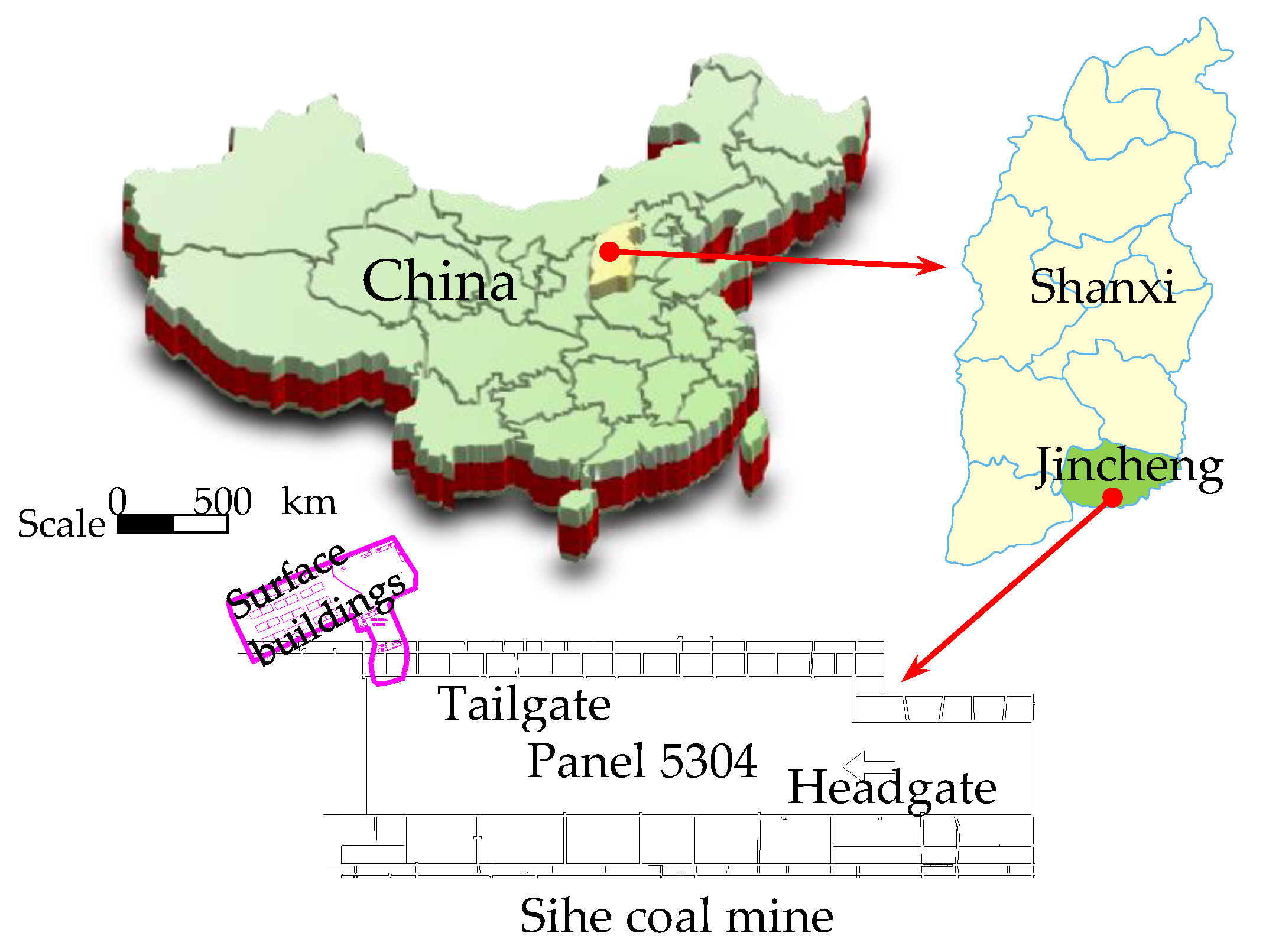
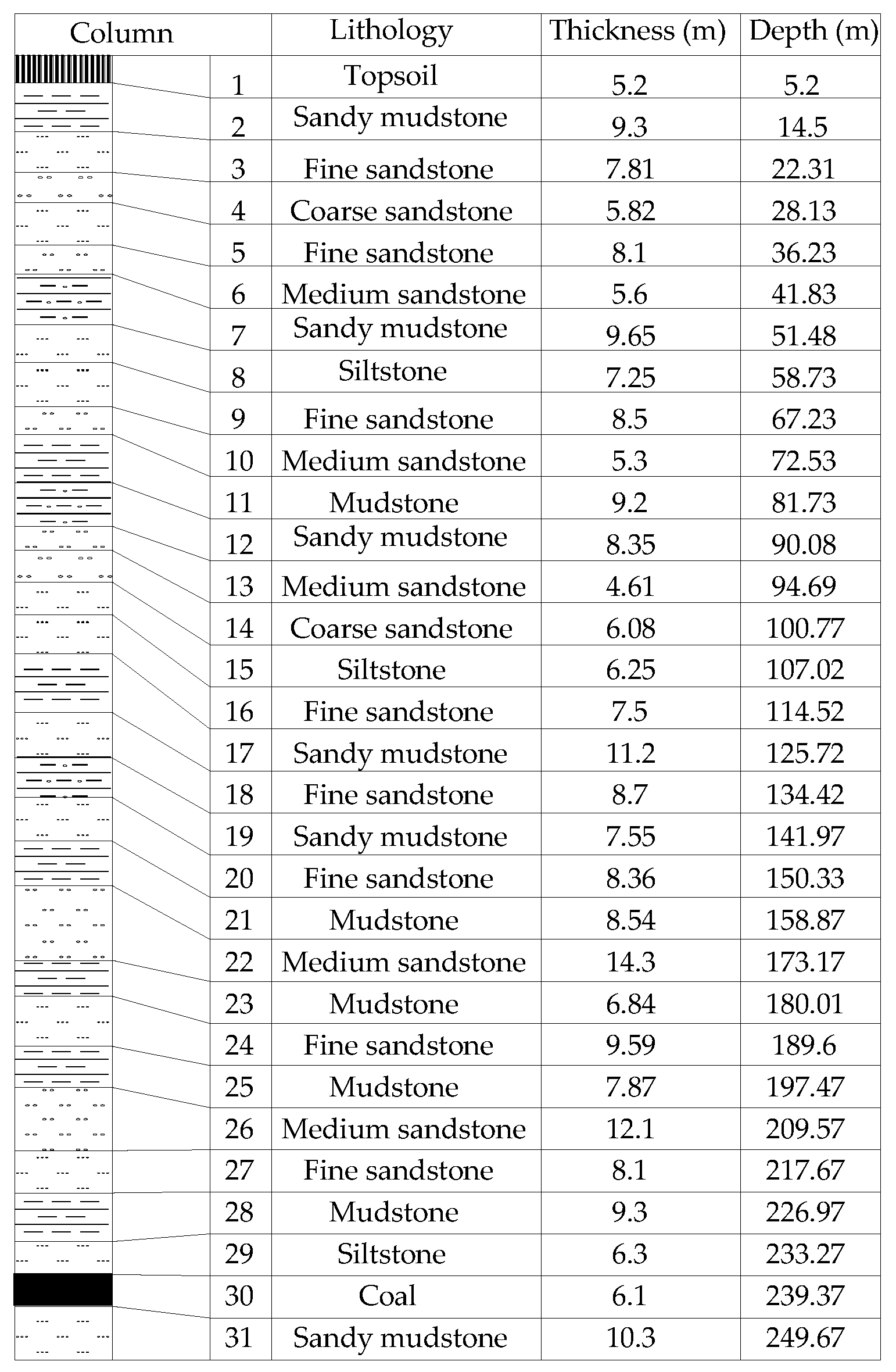

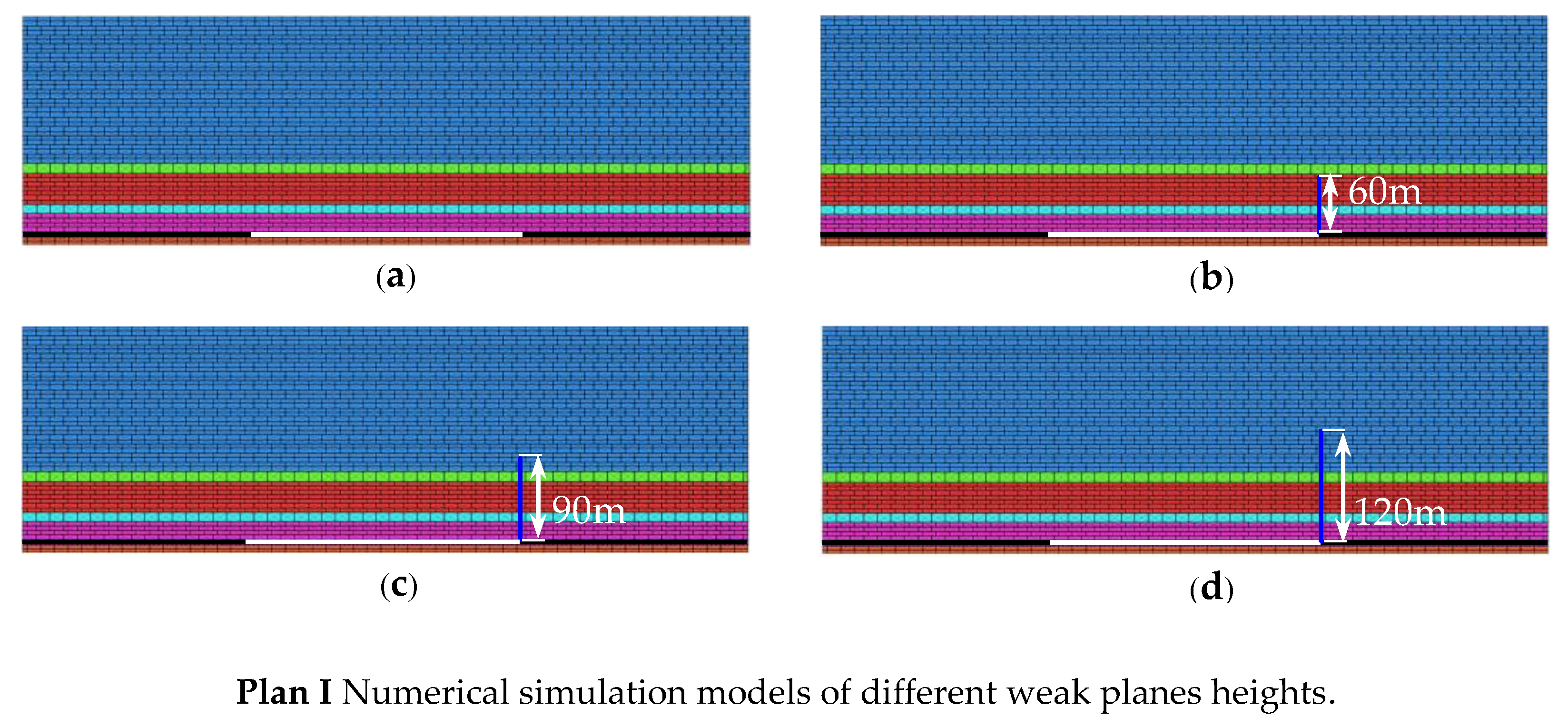
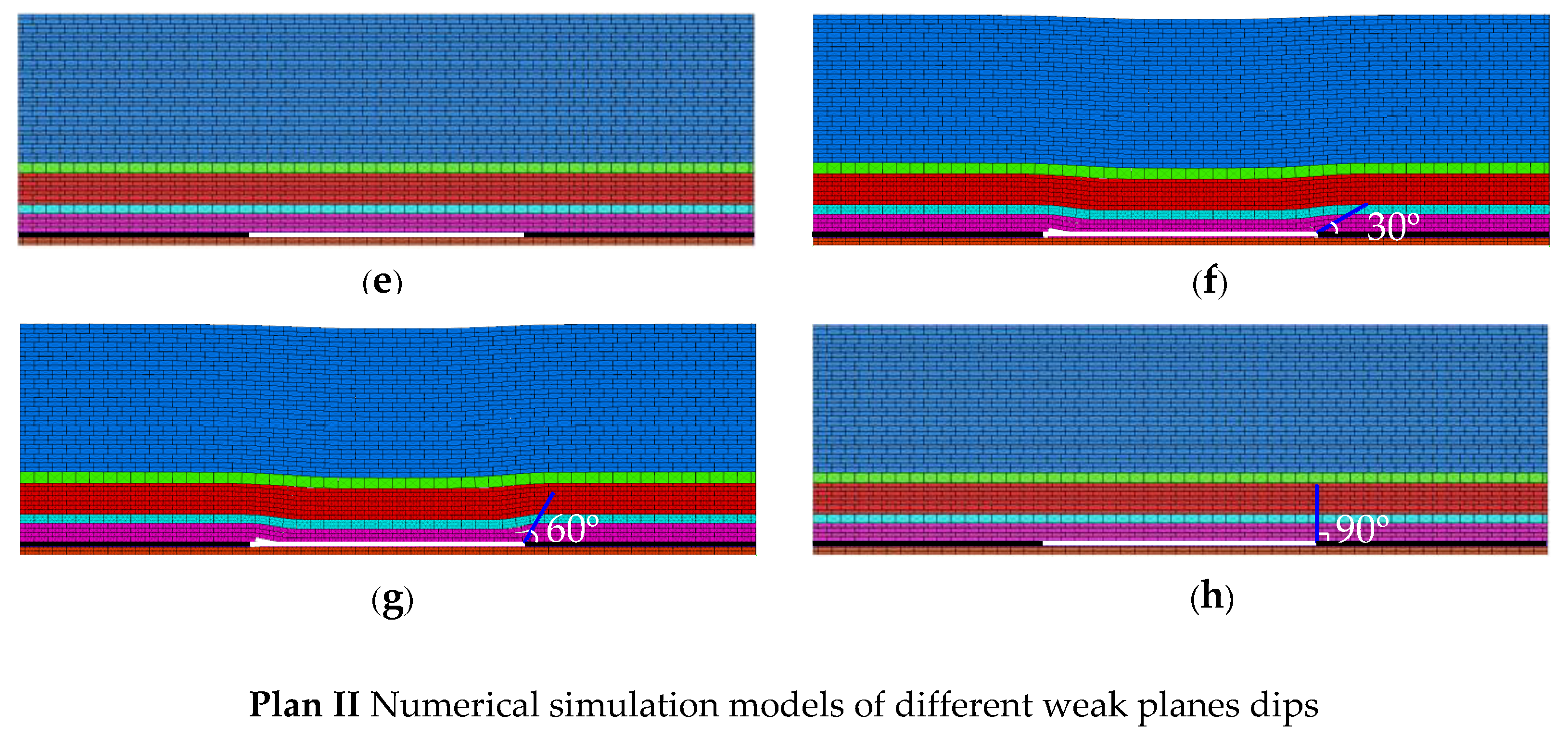
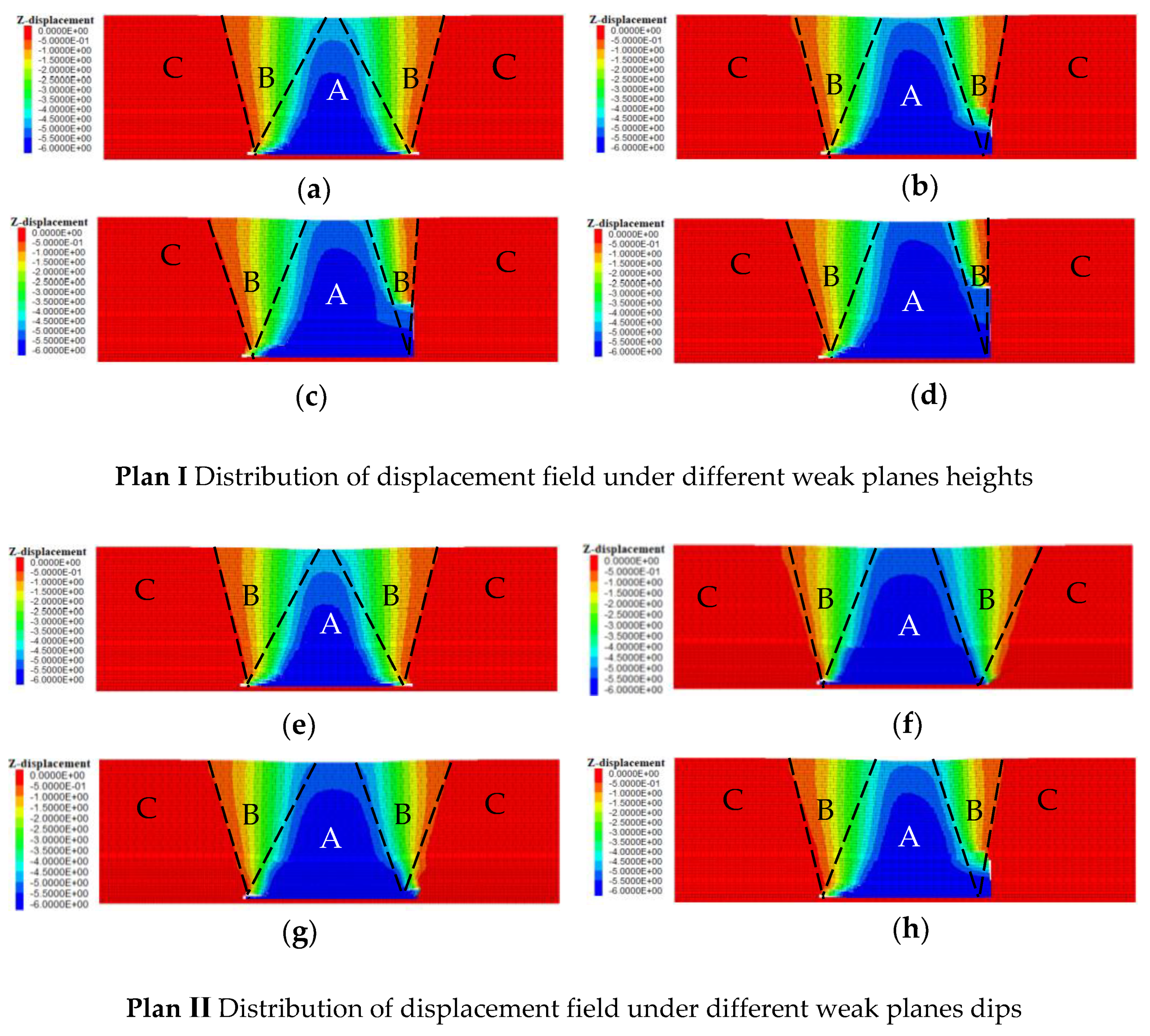
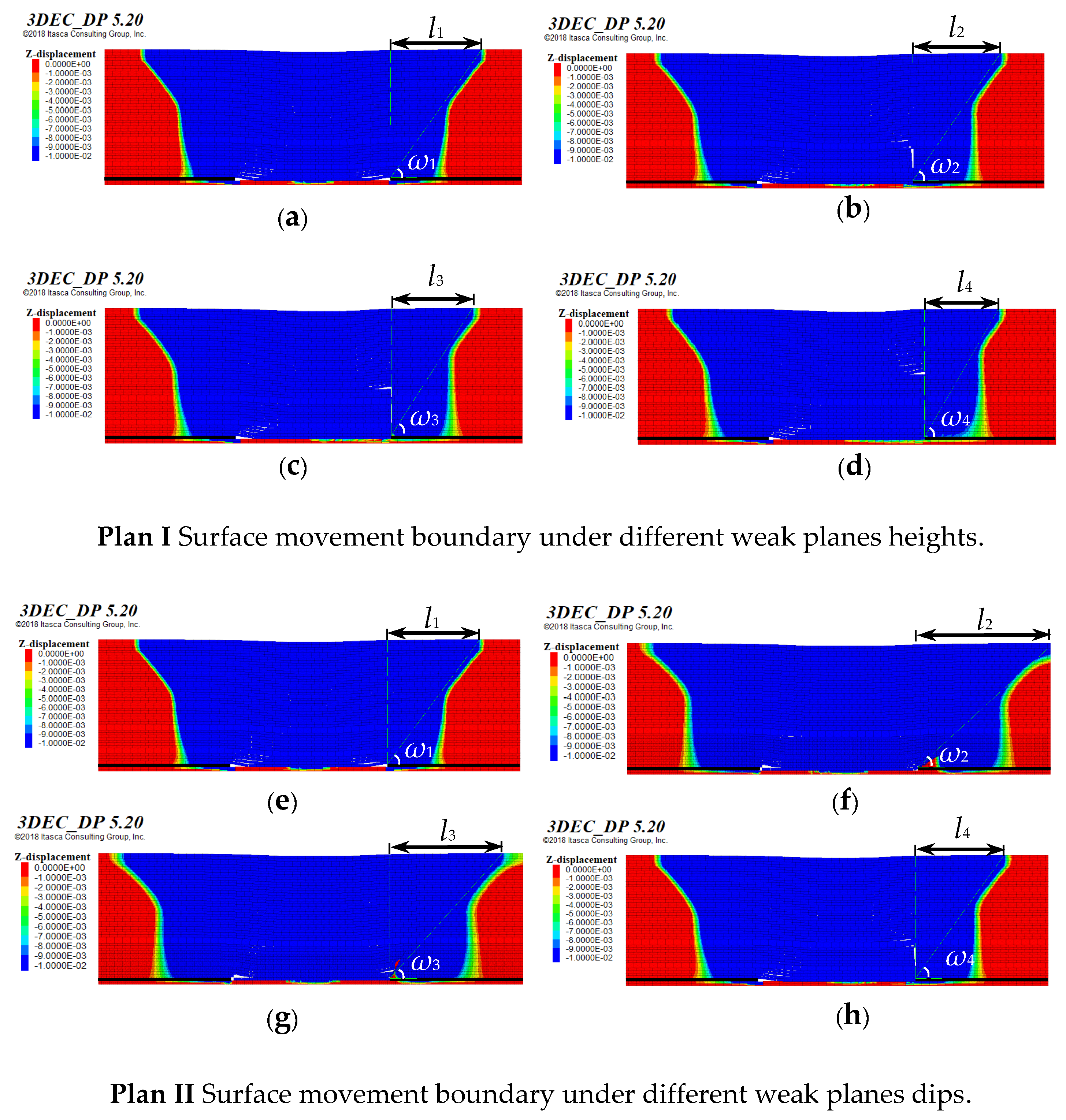

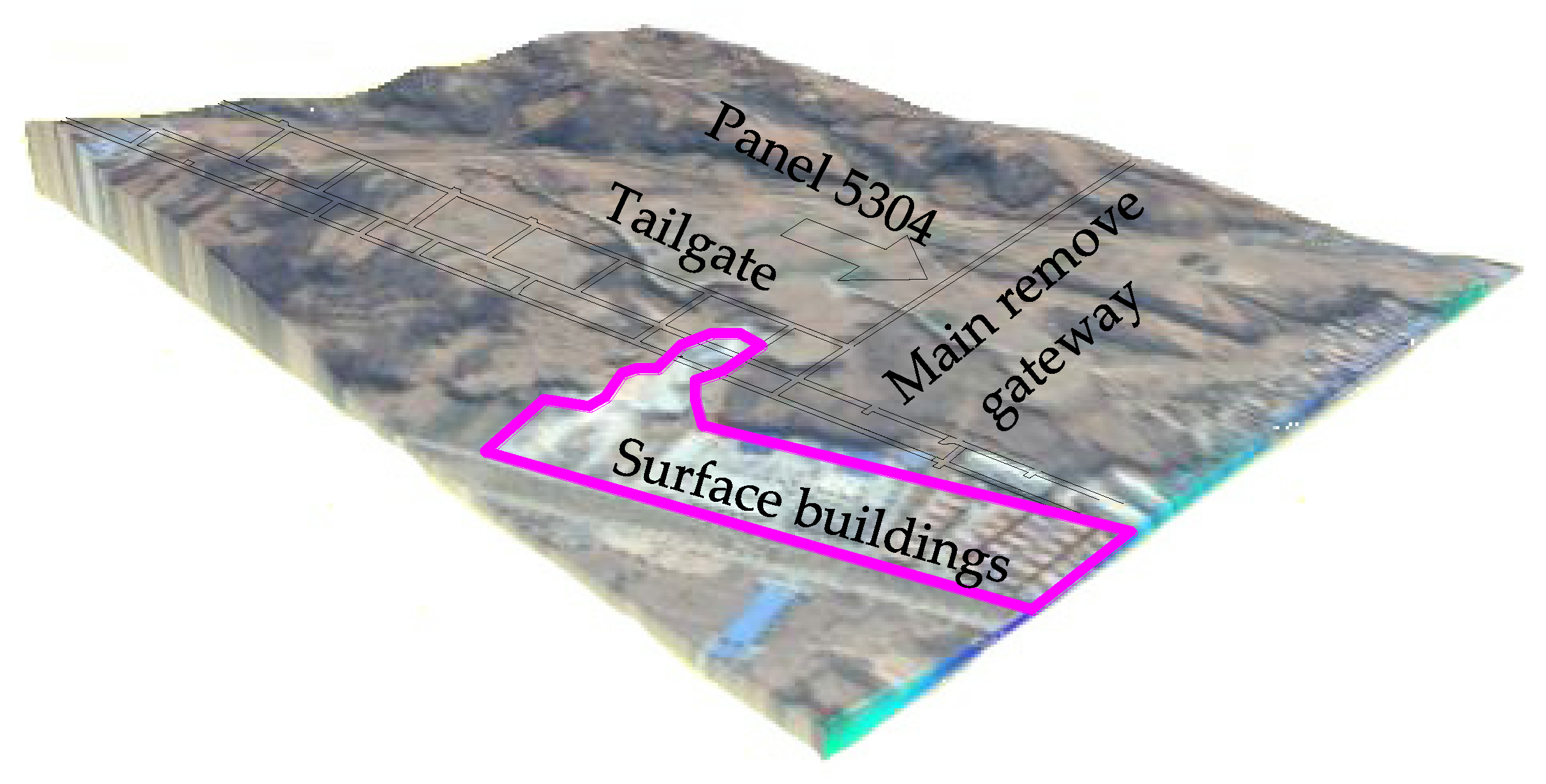

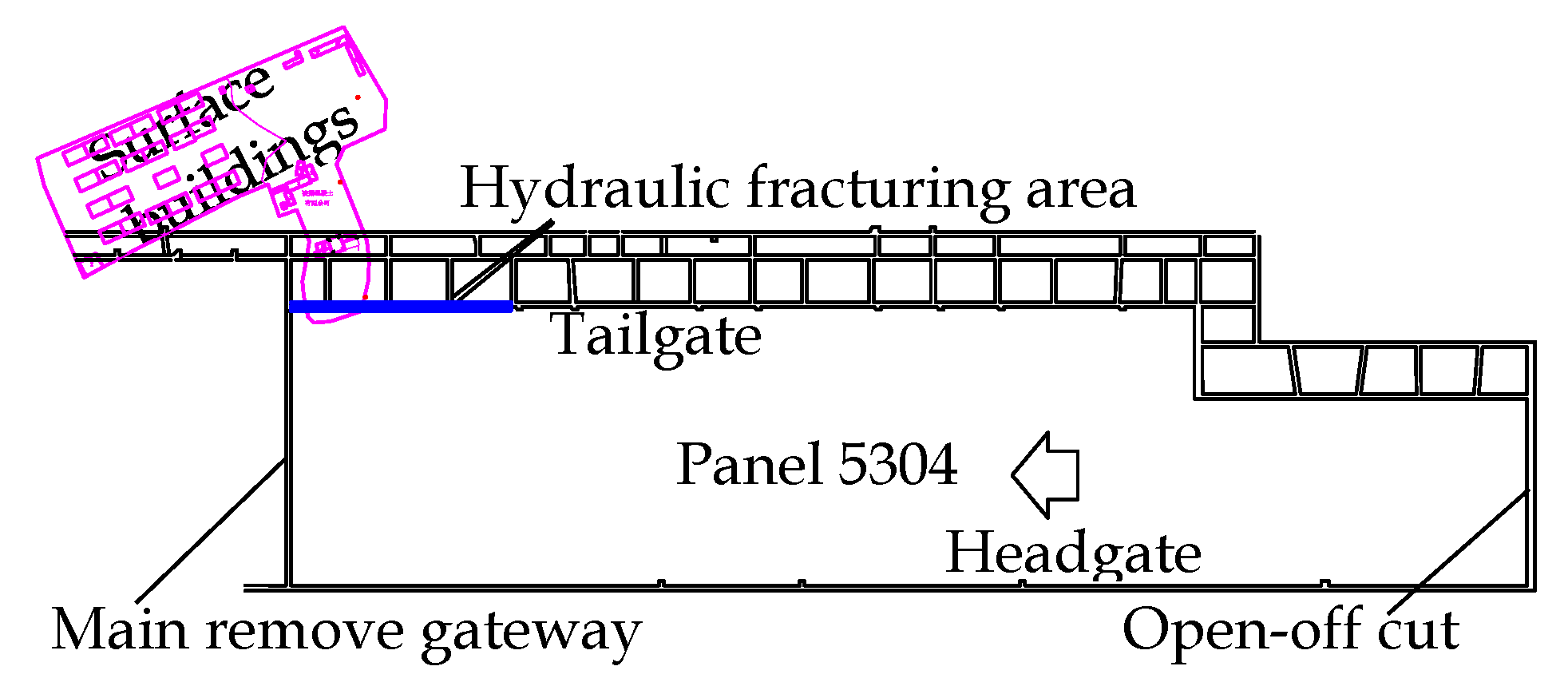
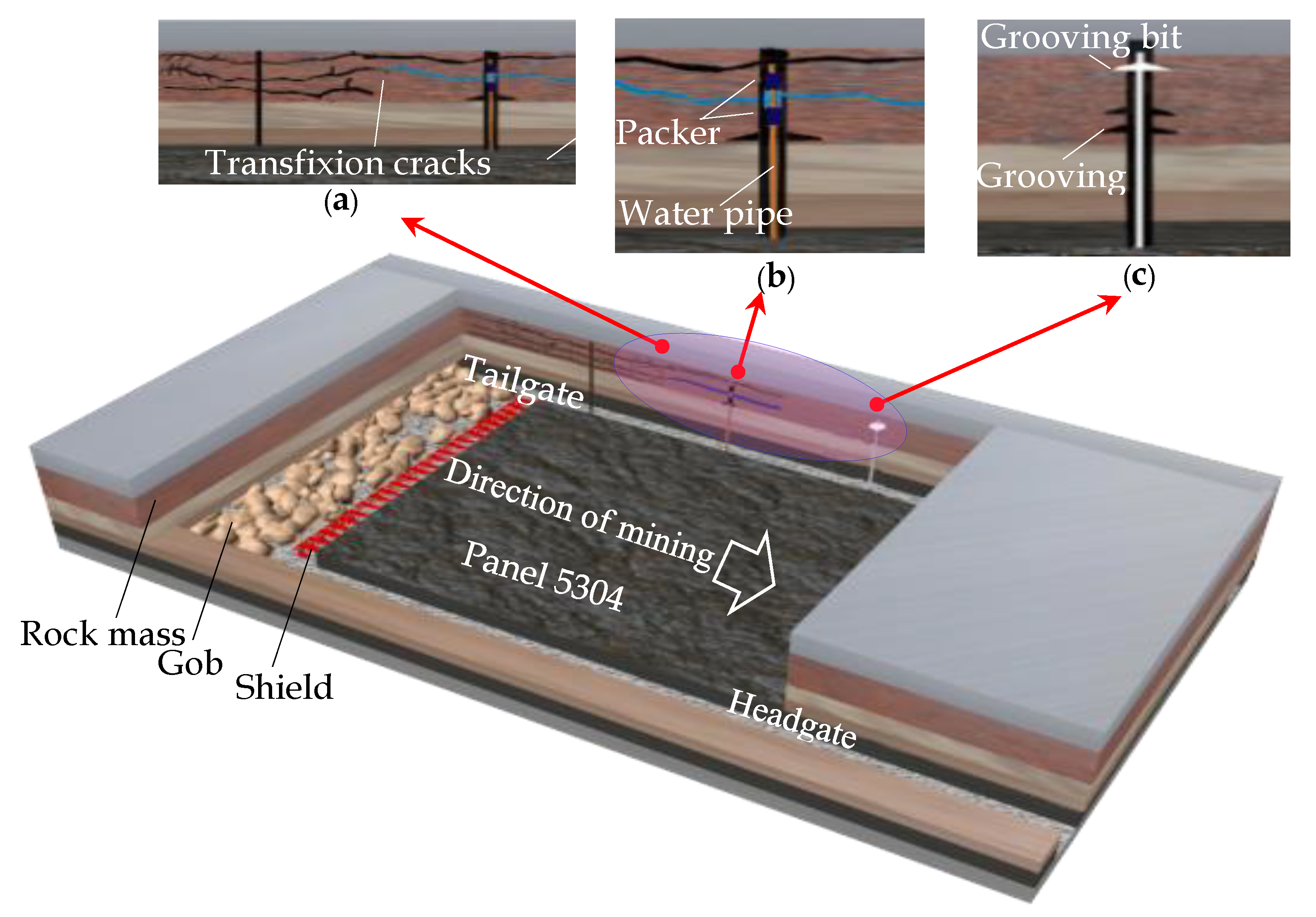
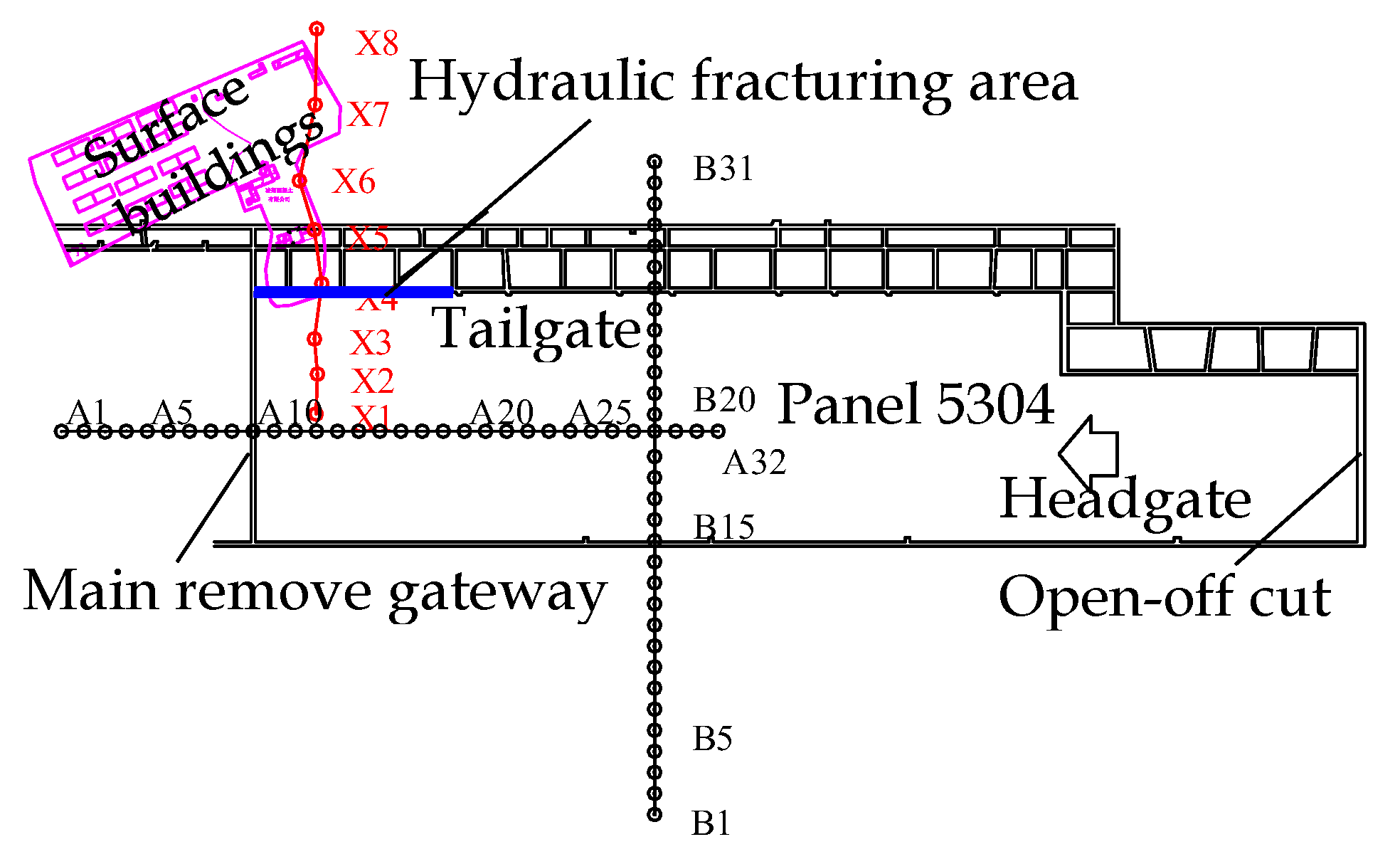


| Parameters | Density (kg·m−3) | Bulk Modulus (GPa) | Shear Modulus (GPa) | Tensile Strength (MPa) | Cohesion (MPa) | Internal Friction Angle (°) | |
|---|---|---|---|---|---|---|---|
| Lithology | |||||||
| Topsoil | 1300 | 0.41 | 0.15 | 0.8 | 0.1 | 20 | |
| Mudstone | 2220 | 2.8 | 1.2 | 1.3 | 1.5 | 18 | |
| Fine sandstone | 2650 | 1.9 | 0.95 | 1.1 | 0.78 | 25 | |
| Coarse sandstone | 2200 | 6.3 | 2.1 | 5.8 | 1.37 | 30 | |
| Medium sandstone | 2460 | 3.5 | 1.78 | 1.5 | 0.89 | 27 | |
| Siltstone | 2300 | 3.4 | 1.7 | 1.45 | 3.2 | 20 | |
| Sandy mudstone | 2100 | 2.7 | 1.2 | 1.3 | 1.5 | 18 | |
| 3# coal seam | 1800 | 2.8 | 0.74 | 1.2 | 2.3 | 38 | |
| Broken zone | 2400 | 0.082 | 0.038 | 0.25 | 0.5 | 30 | |
| Plan | Model | Weak Planes Heights (m) | Advance Angle of Influence (°) | Advance Distance of Influence (m) |
|---|---|---|---|---|
| I | a | 0 | 53.61 | 173.31 |
| b | 60 | 54.57 | 167.13 | |
| c | 90 | 56.59 | 154.81 | |
| d | 120 | 59.15 | 140.27 |
| Plan | Model | Weak Planes Dips (°) | Advance Angle of Influence (°) | Advance Distance of Influence (m) |
|---|---|---|---|---|
| II | e | 0 | 53.61 | 173.31 |
| f | 30 | <45 | >250 | |
| g | 60 | 48.26 | 209.83 | |
| h | 90 | 54.57 | 167.13 |
© 2019 by the authors. Licensee MDPI, Basel, Switzerland. This article is an open access article distributed under the terms and conditions of the Creative Commons Attribution (CC BY) license (http://creativecommons.org/licenses/by/4.0/).
Share and Cite
Feng, Z.; Guo, W.; Xu, F.; Yang, D.; Yang, W. Control Technology of Surface Movement Scope with Directional Hydraulic Fracturing Technology in Longwall Mining: A Case Study. Energies 2019, 12, 3480. https://doi.org/10.3390/en12183480
Feng Z, Guo W, Xu F, Yang D, Yang W. Control Technology of Surface Movement Scope with Directional Hydraulic Fracturing Technology in Longwall Mining: A Case Study. Energies. 2019; 12(18):3480. https://doi.org/10.3390/en12183480
Chicago/Turabian StyleFeng, Zhanjie, Wenbing Guo, Feiya Xu, Daming Yang, and Weiqiang Yang. 2019. "Control Technology of Surface Movement Scope with Directional Hydraulic Fracturing Technology in Longwall Mining: A Case Study" Energies 12, no. 18: 3480. https://doi.org/10.3390/en12183480
APA StyleFeng, Z., Guo, W., Xu, F., Yang, D., & Yang, W. (2019). Control Technology of Surface Movement Scope with Directional Hydraulic Fracturing Technology in Longwall Mining: A Case Study. Energies, 12(18), 3480. https://doi.org/10.3390/en12183480




